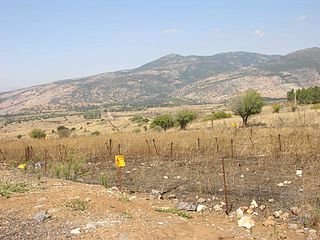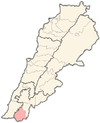Related Research Articles

On July 25, 1993, Israeli forces launched a week-long attack against Lebanon named Operation Accountability in Israel and the Seven-Day War in Lebanon. Israel specified three purposes to the operation, to strike directly at Hezbollah, to make it difficult for Hezbollah to use southern Lebanon as a base for striking Israel, and to displace Lebanese and Palestinian civilians in the hopes of pressuring the Lebanese government to intervene against Hezbollah. The affected civilian population included both Lebanese and Palestinian people.

Ehud "Udi" Goldwasser was an Israeli soldier who was abducted in Israel by Hezbollah along with Eldad Regev on 12 July 2006, sparking the 2006 Lebanon War. His rank was First Sergeant.

Eldad Regev was an Israeli soldier captured by Hezbollah fighters along with Ehud Goldwasser on 12 July 2006 in Israel near the Lebanese border, sparking the 2006 Lebanon War. His rank was Sergeant First Class.
This is a timeline of events related to the 2006 Lebanon War.

The South Lebanon conflict, designated by Israel as the Security Zone in Lebanon Campaign, was a protracted armed conflict that took place in southern Lebanon from 1985 to 2000. It saw fighting between Israel and the Catholic Christian-dominated South Lebanon Army (SLA) against Hezbollah-led Shia Muslim and left-wing guerrillas within the Israeli-occupied "Security Zone"; the SLA had military and logistical support from the Israel Defense Forces over the course of the conflict and operated under the jurisdiction of the Israeli-backed South Lebanon provisional administration, which succeeded the earlier Israeli-backed State of Free Lebanon. It can also refer to the continuation of the earlier conflict in this region involving the growing Palestinian insurgency in South Lebanon against Israel following the expulsion of the Palestine Liberation Organization (PLO) from Jordan after Black September. Historical tensions between Palestinian refugees and Lebanese factions contributed another layer to the Lebanese Civil War (1975–1990), which saw the Maronite-led Lebanese Front and the Shia Amal Movement at war with the PLO. Hence, the South Lebanon conflict can partly be seen as an extension of the civil war that ended in 1990.

The Battle of Bint Jbeil was one of the main battles of the 2006 Lebanon War. Bint Jbeil is a major town of some 20,000 inhabitants in Southern Lebanon. Although Brig.-Gen. Gal Hirsch announced on 25 July that the Israel Defense Forces (IDF) had "complete control" of Bint Jbeil, this statement was later discredited. In spite of three sustained attempts by the IDF to conquer the town, it remained in the hands of Hezbollah until the end of the war. The town was the scene of some of the fiercest fighting of the war, with both sides taking heavy losses. Three senior Israeli officers, including Major Roi Klein, were killed in the battle. Hezbollah similarly lost several commanders, most notably Khalid Bazzi, commander of the Bint Jbeil area.
The Battle of Maroun al-Ras was a battle of the 2006 Lebanon War that took place in Maroun ar-Ras, a small village in southern Lebanon on the border with Israel, and Jall ad-Dayr, a nearby Hezbollah stronghold. This battle was the first serious ground battle in the 2006 Lebanon war. It was fought to a large extent by elite forces on both sides and would have huge consequences for the future of the war. Although, Israeli forces captured most of the town, they did not fully secure it.
There have been many casualties in the 2006 Lebanon War, leading to condemnation of both sides, however the exact distribution of casualties has been disputed. The Lebanese Higher Relief Council (HRC), UNICEF, and various press agencies and news organizations have stated that most of those killed were Lebanese civilians, however the Lebanese government does not differentiate between civilians and combatants in death toll figures. The Israeli government identified 43 Israeli civilians killed by Hezbollah rocket attacks, including four who died of heart attacks during rocket attacks. The Israel Defense Forces (IDF) death toll ranges from 118 to 121, depending on the source and whether or not casualties that occurred after the ceasefire are included. The figures for the Hezbollah fighters killed are the most varying, with Hezbollah claiming 250 of its fighters killed, while Israel claimed to have identified 530 dead Hezbollah fighters. The IDF estimates 600–700 dead Hezbollah fighters. Sources can be conflicting.

The 2006 Hezbollah cross-border raid was a cross-border attack carried out by Lebanon-based Hezbollah militants on an Israeli military patrol on 12 July 2006 on Israeli territory.

The 2006 Lebanon War, also called the 2006 Israel–Hezbollah War and known in Lebanon as the July War and in Israel as the Second Lebanon War, was a 34-day armed conflict in Lebanon, northern Israel and the Golan Heights. The principal parties were Hezbollah paramilitary forces and the Israel Defense Forces (IDF). The conflict started on 12 July 2006, and continued until a United Nations-brokered ceasefire went into effect in the morning on 14 August 2006, though it formally ended on 8 September 2006 when Israel lifted its naval blockade of Lebanon. Due to unprecedented Iranian military support to Hezbollah before and during the war, some consider it the first round of the Iran–Israel proxy conflict, rather than a continuation of the Arab–Israeli conflict.
The Operation Change of Direction 11 was the final offensive operation by the Israel Defense Forces (IDF) during the 2006 Lebanon War that began on August 11, 2006, and ended three days later when the ceasefire came into effect. It involved a tripling of Israeli forces inside Lebanon and aimed at encircling Hizbullah forces in south Lebanon. The plan was to advance westwards along the Litani River from the Galilee Panhandle, combined with helicopter landings behind enemy lines, intended to be the largest in IDF history, and simultaneous advances northwards in the central sector and along the Mediterranean coast. The plan was to follow up the offensive by several weeks of mopping-up operations in the surrounded territories, eliminating Hizbullah infrastructure, especially in the launching areas of Katyusha rockets.

The 2000–2006 Shebaa Farms conflict was a low-level border conflict between Israel and Hezbollah for control of Shebaa Farms, a disputed territory located on the Golan Heights–Lebanon border. Fighting between the two sides primarily consisted of Hezbollah rocket and mortar attacks on Israel and Israeli artillery barrages and airstrikes on Hezbollah in southern Lebanon. Clashes began a few months after the 2000 Israeli withdrawal from Lebanon, which Hezbollah viewed as incomplete due to the presence of the Israel Defense Forces in Shebaa Farms. The conflict culminated in the 2006 Lebanon War; Israel retains control over the territory.
The Battle of Wadi Saluki also known as the Battle of Wadi al-Hujeir was a battle within the framework of Operation Change of Direction 11 that took place at the end of the Second Lebanon War between the armored forces of the 162nd Division, 401st Brigade, and infantry of the Nahal Brigade and the Combat Engineering Corps and Hezbollah fighters, in the area of river Saluki and the villages of Ghanduriyah and Faron. The battle is considered one of the hardest-fought battles in the Second Lebanon War.
The Lebanese–Syrian border clashes were a series of clashes on the Lebanon–Syria border caused by the ongoing Syrian Civil War.

The Qalamoun offensive (2014) was launched by the Syrian Army, in coordination with the Lebanese militia Hezbollah, during the Syrian Civil War against remnant rebel forces following the previous Battle of Qalamoun which resulted in the military securing all of the towns in the region.

Hezbollah involvement in the Syrian civil war has been substantial since the beginning of armed insurgency phase of the Syrian civil war in 2011, and evolved into active support for Syrian government forces and troop deployment from 2012 onwards. By 2014, Hezbollah was deployed across Syria. Hezbollah has also been very active in preventing Al-Nusra Front and Islamic State penetration into Lebanon, being one of the most active forces in the Syrian Civil War spillover in Lebanon.
The Iran–Israel conflict during the Syrian civil war refers to the Iranian–Israeli standoff in and around Syria during the Syrian conflict. With increasing Iranian involvement in Syria from 2011 onwards, the conflict shifted from a proxy war into a direct confrontation by early 2018.
Events in the year 2023 in Lebanon.

Exchange of strikes between Israel and Lebanese militant group Hezbollah have been occurring along the Israel–Lebanon border and in Syria and the Israeli-occupied Golan Heights since 8 October 2023. It is currently the largest escalation of the Hezbollah–Israel conflict to have occurred since the 2006 Lebanon War, and part of the spillover of the Israel-Hamas war.
References
- ↑ Two Israeli soldiers killed in Hezbollah revenge attack
- ↑ Johnston, Holly (2 November 2023). "At least four killed in Israeli attacks on Lebanon as border fighting rages". The National. Retrieved 3 November 2023.
